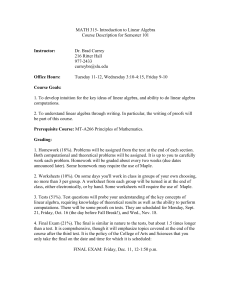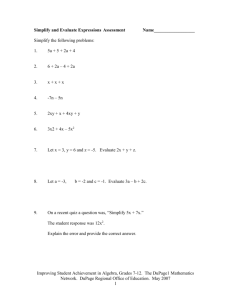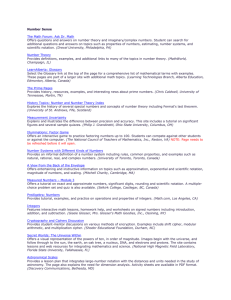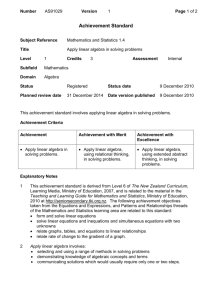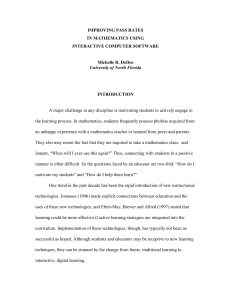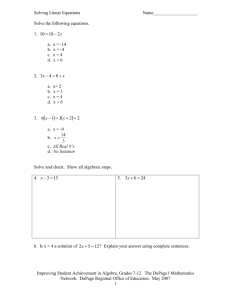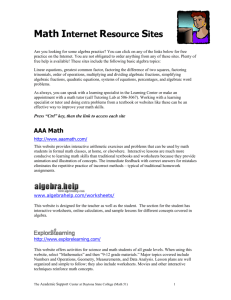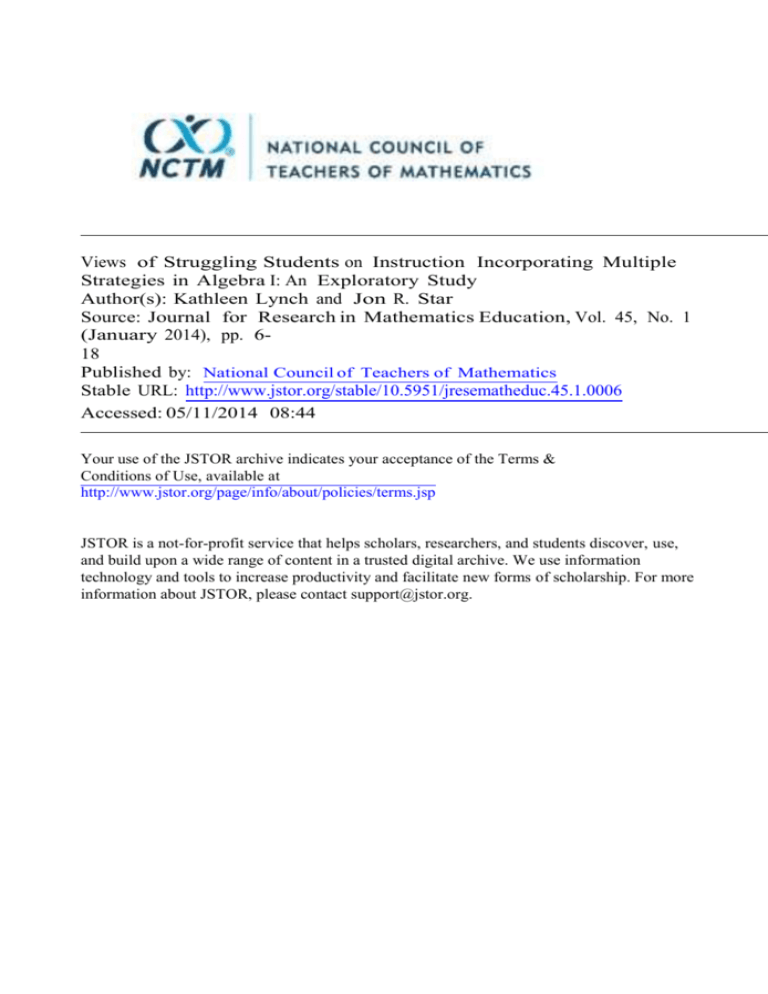
Views of Struggling Students on Instruction Incorporating Multiple
Strategies in Algebra I: An Exploratory Study
Author(s): Kathleen Lynch and Jon R. Star
Source: Journal for Research in Mathematics Education, Vol. 45, No. 1
(January 2014), pp. 618
Published by: National Council of Teachers of Mathematics
Stable URL: http://www.jstor.org/stable/10.5951/jresematheduc.45.1.0006
Accessed: 05/11/2014 08:44
Your use of the JSTOR archive indicates your acceptance of the Terms &
Conditions of Use, available at
http://www.jstor.org/page/info/about/policies/terms.jsp
JSTOR is a not-for-profit service that helps scholars, researchers, and students discover, use,
and build upon a wide range of content in a trusted digital archive. We use information
technology and tools to increase productivity and facilitate new forms of scholarship. For more
information about JSTOR, please contact support@jstor.org.
National Council of Teachers of Mathematics is collaborating with JSTOR to
digitize, preserve and extend access to Journal for Research in Mathematics
Education.
http://www.jstor.org
This content downloaded from
128.192.24.39 on Wed, 5
Nov 2014 08:44:32 AM All
use subject to JSTOR
Terms and Conditions
Copyright © 2014 by the National Council of Teachers of Mathematics, Inc., www.nctm.org. All rights reserved. This
material may not be copied or distributed electronically or in other formats without written permission from NCTM.
Brief Report
Views of Struggling Students on Instruction
Incorporating Multiple Strategies in
Algebra I: An Exploratory Study
Kathleen Lynch and Jon R. Star
Harvard Graduate School of Education
Although policy documents promote teaching students multiple strategies for solving
mathematics problems, some practitioners and researchers argue struggling
learners will be confused and overwhelmed by this instructional practice. In the current
exploratory study, we explore how 6 struggling students viewed the practice of
learning multiple strategies at the end of a yearlong algebra course that emphasized
this practice. Interviews with these students indicated they preferred instruction with
multiple strategies to their regular instruction, often noting it reduced their
confusion. We discuss directions for future research emerging from this work.
Key words: Algebra and algebraic thinking; High school education; Middle school
education; Multiple strategies
Recently, calls for “algebra for all” have pressured school districts to enroll
students of all learning backgrounds in Algebra I, often as early as the seventh or
eighth grade (Kilpatrick, 2009). It is also clear, however, that students with weaker
preparation frequently struggle in algebra classrooms (Steele & Steele, 2003). As
more students of diverse learning backgrounds enter Algebra I classrooms, the
question of how to most effectively teach struggling algebra students has become
increasingly important (Stein, Kaufman, Sherman, & Hillen, 2011).
One promising instructional approach with the potential to improve struggling students’ learning of algebra is the practice of comparing and discussing
multiple solution strategies for mathematics problems. There is increasing
evidence that this practice benefits students’ learning (e.g., Star & Rittle-Johnson,
2008). It is also recommended in many recent policy reports in the United States
(National Council of Teachers of Mathematics, 2006; National Research Council,
2001; Woodward et al., 2012), including the Common Core State Standards
Thanks to Courtney Pollack, Nataliia Perova, Kristie Newton, Bethany RittleJohnson, Christine Size, and Erin O’Connell for their assistance in data collection
and analysis. This research is supported by a grant to the second author from the
National Science Foundation (DRL-0814571). Any opinions, findings, and conclusions or recommendations expressed in this material are those of the authors
and do not necessarily reflect the views of the National Science Foundation.
This content downloaded from 128.192.24.39 on Wed, 5 Nov 2014 08:44:32 AM
All use subject to JSTOR Terms and Conditions
Kathleen Lynch and Jon R. Star
7
(National Governors Association Center for Best Practices & Council of Chief
State School Officers, 2010).
Despite apparent professional consensus, debate continues about whether
instruction with multiple strategies is beneficial to all students or only to highachieving students. These doubts come primarily from the practitioner community, but they also have some support from researchers. For example, Silver,
Ghousseini, Gosen, Charalambous, and Strawhun (2005) found many teachers
believed exploring multiple strategies would be feasible only with high-ability
students. In addition, some researchers in special education advocate the presentation of a limited range of solution strategies (Montague, 1992; Scheuermann,
Deshler, & Schumaker, 2009), perhaps due to a perception that the cognitive load
of a multiple-strategies approach may overwhelm struggling students (e.g., Baxter,
Woodward, & Olson, 2001; Baxter, Woodward, Voorhies, & Wong, 2002). Baxter,
Woodward, and Olson (2001) noted some researchers in special education
view the discussion of alternative strategies and invented algorithms, a common
approach in reform-based mathematics instruction, as problematic for low achievers
because they believe multiple approaches to solving problems or even computing can
only lead to confusion. These researchers see one simple set of rules as the best
approach to teaching these students. (p. 530)
In this exploratory study, we consider the potential impact of instruction emphasizing multiple strategies. The current findings emerged from a pilot study in
which a small group of Algebra I teachers implemented new researcher-developed
Algebra I curriculum materials emphasizing the comparison of multiple strategies. In this brief report, we describe our approach and highlight one element
from our pilot work, the reactions of struggling students,1 that suggests to us the
need for a closer look in future research at struggling algebra learners’
experiences with multiple strategies.
There is not unanimity in the field about what it means to teach mathematics
with multiple strategies (Lynch & Star, in press). In particular, instruction incorporating multiple strategies may include the following four implementation
features. First, the problems used are often nonroutine (i.e., problems where an
algorithm may not exist). Second, students generate or invent their own solutions
to the nonroutine problems. Third, students have an opportunity to compare and
contrast the multiple strategies, which may often involve the use of multiple representations such as symbols, tables, and graphs. And fourth, students and the
teacher engage in a whole-class synthesis discussion around the multiple strategies. Similarly, the incorporation of multiple strategies can have at least two
1 Note that we do not consider the label “struggling” (as in struggling students) to be merely
another way to refer to students with learning disabilities. Both the mathematics education and
special education literatures point out that some (but not all) students with learning disabilities
struggle in mathematics, and some (but not all) students who struggle in mathematics have learning disabilities. However, there is a great deal of research within the field of special education on
how to improve learning disabled students’ performance in mathematics, and this literature is very
informative in our desire to learn more about how to assist struggling students in mathematics.
This content downloaded from 128.192.24.39 on Wed, 5 Nov 2014 08:44:32 AM
All use subject to JSTOR Terms and Conditions
8
Struggling Students’ Views of Multiple Strategies
instructional goals. First, through discussion of multiple strategies, students will
develop understanding of underlying and important mathematical concepts, the
ability to connect between and among different representations, and understanding of the rationale behind common algorithms. And second, students will
know, are held accountable for, and are expected to subsequently use the discussed
multiple strategies in future problem solving. These four features of multiplestrategy instruction, along with the two types of instructional goals, emerged from
research around the learning and teaching of mathematics in elementary school,
particularly the work of the Cognitively Guided Instruction (CGI) project (e.g.
Car penter, Franke, Jacobs, Fennema, & Empson, 1998) combined with an
emphasis on the use of multiple representations in algebra (e.g., Brenner et al.,
1997; Star & Rittle-Johnson, 2009b).
Although we adopt the label multiple-strategy instruction in the present work,
our approach does not incorporate all four implementation features described
above. In particular, instead of having students present and discuss their own
invented solutions to nonroutine problems, the focus of our curriculum materials
was to allow students to present and discuss already-worked pairs of routine
problems, which were presented side-by-side to facilitate comparison and discussion
of multiple contrasting cases. This approach has been used successfully in several
prior studies (e.g., Rittle-Johnson & Star, 2007; Star & Rittle-Johnson, 2009a). In
spite of the fact we do not incorporate two implementation features some may
consider typical or even central to multiple-strategies instruction (student
generation of strategies and use of nonroutine problems), we feel justified in using
the phrase to describe our approach for three reasons. First, it is not unusual for
teachers to introduce strategies not generated by students into a multiple-strategies
discussion, such as when a teacher illustrates an alternative strategy with the
introduction, “A student from another class solved the problem this way—what do
you think of this approach?” Second, with our use of routine problems, the goals
of our curriculum materials are well aligned with both of the instructional goals
noted above. And finally, those concerned with the appropriateness of multiplestrategy instruction indicate it is the comparison of, discussion of, and expectation
of subsequent use of multiple strategies that may overwhelm low achieving students
(e.g., Baxter, Woodward, & Olson, 2001), rather than the invention of alternative
strategies or the specific use of nonroutine problems.
Method
The curricular context for the present study is a set of researcher-designed
instructional materials infusing multiple strategies into a yearlong Algebra I
course. The materials feature the characters Alex and Morgan, who solve problems
using multiple strategies. The curriculum materials used in the current intervention focused on the specific practice of comparing multiple strategies via
students’ discussion of worked examples. More information about the curriculum
materials can be found at http://scholar.harvard.edu/contrastingcases/ (see also
Rittle-Johnson & Star, 2011).
This content downloaded from 128.192.24.39 on Wed, 5 Nov 2014 08:44:32 AM
All use subject to JSTOR Terms and Conditions
Kathleen Lynch and Jon R. Star
9
Figures 1–3 show sample pages from our curriculum. In some example pairs
(Figures 1 and 2), Alex and Morgan are solving the same problem but in two
different ways. In some instances, the instructional goal of this type of comparison
is for students to see and understand alternative ways of solving routine problems,
as in Figure 1, where Alex and Morgan use two mathematically equivalent but (to
students) very different strategies. In other instances, the goal is for students to
understand conceptually why a common strategy works or why a typical error
occurs. For example, in the pair of worked examples shown in Figure 2, where
Alex and Morgan have different approaches for simplifying (62 )(52 ), the comparison of Alex’s and Morgan’s ways is intended to support a discussion that conceptually unpacks what Morgan did and why it works. In other example pairs, Alex
and Morgan solve two different problems but in similar ways. For example,
in Figure 3, Alex graphed the equation y = 3x and Morgan graphed the equation
y = 3x, with the goal of understanding how and why these functions, whose
symbolic representation looks quite similar, result in tables and graphs that have
very important differences. The 141 example pairs that were included in the
complete curriculum covered the entire range of typical Algebra I content.
We developed a structured implementation model to accompany the written
curriculum materials having three class discussion phases—Understand,
Compare, and Make Connections. For each pair of worked examples, we provided
ref lection prompts for each phase. In the Understand phase, prompts such as, “How
did Morgan solve the equation?” were intended to establish student comprehension
of each individual strategy. In the Compare phase, prompts such as, “What are some
similarities and differences between Alex’s and Morgan’s ways?” were intended to
guide students to compare the two strategies. The Understand and Compare phases
were intended to prepare students for the final phase, Make Connections, in which
prompts varied by the pair of worked examples and were intended to focus students’
discussion on the instructional goal of the comparison. Although the worked
examples students compared were routine and frequently involved symbolic
solution methods, the Make Connections phase was centrally concerned with
understanding key algebraic principles. For example, in Figure 1, the discussion is
launched through the questions at the bottom of the page; it is expected the teacher
will use students’ answers to these questions to encourage consideration of why
Alex’s and Morgan’s strategies work and what mathematical principles are
brought to bear in each method. Similarly, in Figure 2, the Make Connections
phase is focused on conceptually unpacking Morgan’s familiar strategy.
Finally, in Figure 3, teachers were encouraged to push students toward
understanding (via graphs, tables, and symbols) how and why linear and exponential functions differ. In this exploratory study, teachers were given f lexibility in
determining implementation details such as which examples to use in a class
period and how much time to dedicate to each phase. For a more detailed discussion
of the implementation model, see Rittle-Johnson and Star (2011).
The study was conducted in a large city in New England and its environs. Twelve
middle and high school Algebra I teachers volunteered to participate in a weeklong
This content downloaded from 128.192.24.39 on Wed, 5 Nov 2014 08:44:32 AM
All use subject to JSTOR Terms and Conditions
10
Struggling Students’ Views of Multiple Strategies
Figure 1. Example of a Which is better? worked example pair.
This content downloaded from 128.192.24.39 on Wed, 5 Nov 2014 08:44:32 AM
All use subject to JSTOR Terms and Conditions
Kathleen Lynch and Jon R. Star
Figure 2. Example of a Why does it work? worked example pair.
This content downloaded from 128.192.24.39 on Wed, 5 Nov 2014 08:44:32 AM
All use subject to JSTOR Terms and Conditions
11
12
Struggling Students’ Views of Multiple Strategies
Figure 3. Example of a How do they differ? worked example pair.
This content downloaded from 128.192.24.39 on Wed, 5 Nov 2014 08:44:32 AM
All use subject to JSTOR Terms and Conditions
13
Kathleen Lynch and Jon R. Star
institute on algebra teaching methods, where they were introduced to the curriculum materials as well as the structured implementation model described above.
Teachers subsequently piloted the instructional materials during a yearlong
Algebra I course.
At the end of the Algebra I course (late May), teachers were instructed to select
interviewees who had a wide range of attitudes and experiences with respect to
the researcher-designed intervention materials—some positive and some negative. The 30-minute interviews were semistructured, exploring students’ experiences in the Algebra I course, par ticularly with multiple st rategies. See
http://scholar.harvard.edu/contrastingcases/ for the interview protocol.
In total, we interviewed 23 students from 10 schools. Of these 23 students,
6 scored in the “low” band of a standardized algebra readiness test administered
at the beginning of the year, indicating the students were unprepared for
Algebra I and at an increased risk of subsequent low performance in the course.
We targeted these 6 students’ interviews for analysis because of our interest in the
experiences of struggling students. Keisha (9th percentile on the pretest) was in the
eighth grade, whereas Mark (25th percentile), Gina (22nd percentile), Jordan
(15th percentile), Isabel (1st percentile), and Nicole (1st percentile) were in the
ninth grade.
Analysis of the inter views was conducted collaboratively, with multiple
researchers engaging in coding and discussions (e.g., Lincoln & Guba, 1985).
Although interviews touched on a range of topics, in this brief report we focus
on students’ perceptions of the advantages and disadvantages of learning with
multiple strategies. We examined each student’s complete interview for any references to advantages or disadvantages of learning with multiple strategies, both in
questions specifically asked for perceptions of advantages and disadvantages as
well as in all other sections of the interview. The unit of analysis was the conversational turn, or statement bounded by a shift in speakers (also referred to by some
researchers as a move or utterance), which could be a statement, a question, or an
answer (Johnstone, 2002). After developing initial categories relating to advantages and disadvantages, we reexamined the interviews for evidence that might
challenge our categories, constantly comparing identified codes with the original
data. We resolved all disagreements through discussion until we reached
consensus.
Results
General Reactions to Instruction Using Multiple Strategies
Students generally appeared to find the emphasis on more than one way to solve
an algebraic problem relatively novel; five of the six noted their previous
teachers had infrequently or never emphasized this practice. To assess students’
general reactions, interviewers asked students what they thought about the focus
on learning more than one way to solve problems. All of the students described
multiple strategies as an improvement over “business as usual.” Several students
This content downloaded from 128.192.24.39 on Wed, 5 Nov 2014 08:44:32 AM
All use subject to JSTOR Terms and Conditions
14
Struggling Students’ Views of Multiple Strategies
stated they enjoyed the multiple-strategy focus (N = 5). Learning multiple
strategies had improved their understanding and alleviated their past difficulties
(N = 4), improved their problem-solving success rate (N = 2), improved their
attitudes toward mathematics (N = 1), and was thought provoking (N = 1).
Perceived Advantages
The most commonly cited advantage for multiple strategies, cited by all six of
the students, was an increased awareness of different methods. Mark, for example,
commented,
I thought it was better because it could like, open different ways of how to do the
problems. So like one way could be the way that everybody else was doing, and it
could be hard, but then with Alex and Morgan, you see a different way to do it, that
could be easier.,
A second advantage, described by four students, was helping students find a
method that “worked for them.” Gina, for example, stated,
I liked the multiple different ways, because the way some teachers have showed me
in the past . . . they might’ve not worked for me as well. But then now because I’ve
seen, like, a different way, I like, may possibly like another way better. And I’m a lot
better at it.
Three students described multiple strategies as “easier” than learning one way; in
a typical comment, Jordan stated,
Learning different ways of how to solve a problem was the best part. Because, there
are some times where, there was only one way, I would have only learned one way,
but then when you find a different way to do it, it’s so much easier to you.
Although many students spoke of affective advantages, two students more
explicitly noted reduced anxiety about mathematics. For example, Keisha noted,
I think it’s great, because sometimes, people, they’re doing these kinds of problems,
and they don’t understand how to do them, but then if you’re shown another way, and
you’re shown to do it better, and it’s just, it can take relief off of some people. And I
know it did for me.
In addition, students noted multiple strategies could improve accuracy (N =
2), provide a “back-up” method (N = 1), facilitate checking answers (N = 1), and
help differentiate correct approaches (N = 1). Isabel, who had also stated the
materials helped her to understand the steps to solve different equations, additionally alluded to the relative efficiency of the strategies of Alex and Morgan:
Yeah, it helps, because instead of just using one strategy that’s like, the longest, sometimes you would see that Alex was using a shorter way, or Morgan did. So I sometimes
would use both ways, to like, solving an equation. It was cool, because I got to use
the shorter way, which was much faster.
This content downloaded from 128.192.24.39 on Wed, 5 Nov 2014 08:44:32 AM
All use subject to JSTOR Terms and Conditions
15
Kathleen Lynch and Jon R. Star
Perceived Disadvantages
Compared with the advantages, students cited disadvantages less frequently.
Four students stated for them, there were no disadvantages to this approach. In a
typical comment, Mark stated, “Nothing, really. I thought it was, like, I thought
it was helpful.” Three students made reference to the possibility of confusion at
some point in the interviews. One student, Nicole, who stated she had not
experienced any disadvantages from learning with multiple strategies,
mentioned her teacher had used specific techniques when introducing multiple
strategies “so we’re not confused,” including instructing the class to first look
over Alex and Morgan’s solutions and then to read Alex and Morgan’s narrations
of their steps. Two students, Jordan and Keisha, referenced confusion as a
possibility for them more directly. For example, Keisha noted “the disadvantages would be the other problem confusing you, and you not knowing which one
to use or if that one’s correct or not.” Keisha also commented, however, this had
never happened to her because she was able to identify methods she was
successful with and discard others.
Overall, what stands out about these comments is that although the risk of confusion appears real, students described their worries about confusion more sporadically and less forcefully than they described their appreciation of multiple strategies. Indeed, all of the students in the current sample said there were more
advantages than disadvantages to learning more than one way to solve a
problem.
Discussion
Mathematics instruction using multiple strategies appeared to be a novel experience for the six struggling students in the current sample. Despite its novelty,
these six struggling students had quite positive perceptions of learning with
multiple strategies, a view running counter to the perceptions of teachers in prior
studies (e.g., Silver, Ghousseini, Gosen, Charalambous, & Strawhun, 2005) and
those of some researchers (e.g., Baxter et al., 2002). Concerns about overwhelming
struggling students were largely not substantiated among the students we interviewed. In fact, these six students cited the advantage of improved understanding
and reduced anxiety repeatedly throughout the interviews. Also contrary to what
might have been expected, these six struggling students cited relatively few disadvantages to learning multiple strategies and felt that the risk of confusion was
relatively minor.
How can we explain this disconnect between some teachers’ concerns about
multiple strategies for struggling students generally and these six struggling
students’ own expressed enthusiasm for this practice after a year of engaging with
it? Although our current data do not address this question specifically, we
speculate perhaps some teachers’ hesitation may be rooted in their own real prior
experiences with attempting to present multiple strategies to struggling learners
with unsuccessful results. In this context, we speculate perhaps the specific
This content downloaded from 128.192.24.39 on Wed, 5 Nov 2014 08:44:32 AM
All use subject to JSTOR Terms and Conditions
16
Struggling Students’ Views of Multiple Strategies
structural components of the current intervention and its implementation may have
contributed to its greater success in reaching these six struggling students—in
other words, the how of implementing multiple-strategies instruction mattered a
great deal.
In particular, the current intervention was carefully designed to maximize the
likelihood students would reap the benefits of multiple strategies, while
reducing the likelihood of overload. In particular, our approach incorporated the
following components: (a) already worked examples; (b) carefully selected routine
examples to be compared (such that the compared examples did not vary across
too many dimensions, but rather were mostly similar, so that elements of differences could be easily identified); (c) engaging cartoon characters; (d) explicit,
step-by-step presentation of worked examples in both words (via dialogue bubbles)
and mathematics syntax; and (e) a structured implementation model that gave
guidance to teachers on ways to compare, contrast, and discuss multiple strategies
conceptually and procedurally without overloading students. Certainly teachers’
concerns about overloading students are important and valid. Without careful
consideration of how to teach with multiple strategies, including keen attention to
both selection of examples to be compared and to presentation structure, students
may indeed become confused. Our results suggest, however, with these
elements, even struggling students may benefit from this instructional approach.
The current study is exploratory in nature and has multiple limitations. First,
we used a small convenience sample of volunteer teachers and as such, their adherence to the curriculum developers’ intended implementation model may have been
unusually strong. Second, teachers selected students to be interviewed. Although
teachers were instructed to select interviewees with a wide range of attitudes about
the materials, we have no way to know whether this was indeed the case. Third,
the students were aware the interviewers were members of the research group
creating the materials. As a result, one might speculate the students wished to
please the researchers and say only positive things about the curriculum.
However, we suspect such an effect was relatively minor; students appeared
relatively uninhibited in their critiques of some elements of the intervention.
Finally, our small sample clearly limits our ability to generalize the present
findings.
Conclusions and Future Research Directions
Contrary to what might have been expected from the existing literature, the six
struggling students in the current study described positive experiences from
learning algebra with a multiple-strategies approach. We suggest the current
findings may present a form of existence proof of the conception that under ideal
circumstances, and with carefully designed curriculum materials, struggling
students can emerge from a yearlong algebra course infused with multiple strategies with positive views of this approach, preferring it to their regular instruction.
Although the current findings are exploratory in nature and not argued to be
representative of struggling algebra learners broadly, our results suggest it may
This content downloaded from 128.192.24.39 on Wed, 5 Nov 2014 08:44:32 AM
All use subject to JSTOR Terms and Conditions
17
Kathleen Lynch and Jon R. Star
be productive to revisit the question of whether and how struggling students should
be exposed to multiple strategies. In particular, future studies could examine
classrooms where teachers use a multiple-strategies approach to parse which
elements of instruction and curriculum may best support struggling learners. In
addition, future, larger studies should include student assessments of both procedural and conceptual algebra knowledge in order to evaluate the effectiveness of
instruction with multiple strategies on a larger scale. Future research should also
systematically measure teachers’ fidelity of implementation in order to explore
the critical consideration of whether the curriculum was taught consistently or
modified across classrooms. An additional promising direction for future research
is an extension of the current curriculum materials to include a broader array of
problem types, including nonroutine problems for which there is no defined or
specific solution algorithm or pathway. Our efforts to explore these avenues for
future research are currently underway.
Given the critical need to improve algebra instruction for this growing population, we hope the current exploratory findings might prompt future research to
explore struggling algebra students’ engagement with multiple strategies in
greater depth.
References
Baxter, J., Woodward, J., & Olson, D. (2001). Effects of reform-based mathematics instruction in five
third-grade classrooms. Elementary School Journal, 101(5), 529–548. doi:10.1086/499686
Baxter, J., Woodward, J., Voorhies, J., & Wong, J. (2002). We talk about it, but do they get it? Learning
Disabilities Research & Practice, 17(3), 173–185.
Brenner, M. E., Mayer, R. E., Moseley, B., Brar, T., Duran, R., Reed, B. S., & Webb, D. (1997).
Learning by understanding: The role of multiple representations in learning algebra. American
Educational Research Journal, 34(4), 663–689.
Carpenter, T. P., Franke, M. L., Jacobs, V. R., Fennema, E., & Empson, S. B. (1998). A longitudinal
study of invention and understanding in children’s multidigit addition and subtraction. Journal for
Research in Mathematics Education, 29(1), 3–20.
Johnstone, B. (2002). Discourse analysis (2nd ed.). Malden, MA: Blackwell.
Kilpatrick, J. (2009). Algebra is symbolic. In S. L. Swars, D. W. Stinson, & S. Lemons-Smith (Eds.),
Proceedings of the 31st Annual Meeting of the North American Chapter of the International Group
for the Psychology of Mathematics Education (Vol. 5, pp. 11–21). Atlanta, GA: Georgia State University.
Lincoln, Y. S., & Guba, E. G. (1985). Naturalistic inquiry. Beverly Hills, CA: Sage.
Lynch, K., & Star, J. R. (in press). Teachers’ views about multiple strategies in middle and high school
mathematics: Perceived advantages, disadvantages, and reported instructional practices. Mathematical Thinking and Learning.
Montague, M. (1992). The effects of cognitive and metacognitive strategy instruction on the mathematical problem solving of middle school students with learning disabilities. Journal of Learning
Disabilities, 25(4), 230–248.
National Council of Teachers of Mathematics. (2006). Curriculum focal points for prekindergarten
through grade 8 mathematics. Reston, VA: Author.
National Governors Association Center for Best Practices & Council of Chief State School Officers.
(2010). Common core state standards for mathematics. Retrieved from http://www.corestandards.
org/assets/CCSSI_Math_Standards.pdf
National Research Council. (2001). Adding it up: Helping children learn mathematics. Washington,
DC: National Academy Press.
This content downloaded from 128.192.24.39 on Wed, 5 Nov 2014 08:44:32 AM
All use subject to JSTOR Terms and Conditions
18
Struggling Students’ Views of Multiple Strategies
Rittle-Johnson, B., & Star, J. (2007). Does comparing solution methods facilitate conceptual and procedural knowledge? An experimental study on learning to solve equations. Journal of Educational
Psychology, 99(3), 561–574.
Rittle-Johnson, B., & Star, J. R. (2011). The power of comparison in learning and instruction: Learning
outcomes supported by different types of comparisons. In J. P. Mestre & B. H. Ross (Eds.), Psychology of Learning and Motivation: Cognition in Education (Vol. 55, pp. 199–222). Waltham, MA:
Elsevier. doi:10.1016/B978-0-12-387691-1.00007-7
Scheuermann, A. M., Deshler, D. D., & Schumaker, J. B. (2009). The effects of the explicit inquiry
routine on the performance of students with learning disabilities on one-variable equations. Learning Disability Quarterly, 32(2), 103–120.
Silver, E. A., Ghousseini, H., Gosen, D., Charalambous, C., & Strawhun, B. (2005). Moving from
rhetoric to praxis: Issues faced by teachers in having students consider multiple solutions for problems in the mathematics classroom. Journal of Mathematical Behavior, 24, 287–301.
Star, J. R., & Rittle-Johnson, B. (2008). Flexibility in problem solving: The case of equation solving.
Learning and Instruction, 18, 565–579.
Star, J. R., & Rittle-Johnson, B. (2009a). It pays to compare: An experimental study on computational estimation. Journal of Experimental Child Psychology, 102(4), 408–426. doi:10.1016/j.
jecp.2008.11.004
Star, J. R., & Rittle-Johnson, B. (2009b). Making algebra work: Instructional strategies that deepen
student understanding, within and between representations. ERS Spectrum, 27(2), 11–18.
Steele, M. M., & Steele, J. W. (2003). Teaching algebra to students with learning disabilities. Mathematics Teacher, 96(9), 622–624.
Stein, M. K., Kaufman, J. H., Sherman, M. & Hillen, A. (2011). Algebra: A challenge at the crossroads
of policy and practice. Review of Educational Research, 81(4), 453–492.
Woodward, J., Beckmann, S., Driscoll, M., Franke, M. L., Herzig, P., Jitendra, A. K., . . . Ogbuehi,
P. (2012). Improving mathematical problem solving in grades 4 to 8: A practice guide (NCEE
2012-4055). Washington, D.C.: National Center for Education Evaluation and Regional Assistance,
Institute of Education Sciences, U.S. Department of Education. Retrieved from http://ies.ed.gov/
ncee/wwc/pdf/practice_guides/mps_pg_052212.pdf
Authors
Kathleen Lynch, Harvard Graduate School of Education, Harvard University, 211 Longfellow Hall,
13 Appian Way, Cambridge, MA, 02138; kathleen_lynch@mail.harvard.edu
Jon R. Star, Harvard Graduate School of Education, Harvard University, 442 Gutman Library, 6
Appian Way, Cambridge, MA, 02138; jon_star@harvard.edu
Submitted December 11, 2012
Accepted April 4, 2013
This content downloaded from 128.192.24.39 on Wed, 5 Nov 2014 08:44:32 AM
All use subject to JSTOR Terms and Conditions


